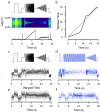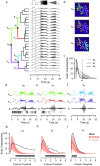Bayesian hypothesis testing and experimental design for two-photon imaging data
- PMID: 31374071
- PMCID: PMC6693774
- DOI: 10.1371/journal.pcbi.1007205
Bayesian hypothesis testing and experimental design for two-photon imaging data
Erratum in
-
Correction: Bayesian hypothesis testing and experimental design for two-photon imaging data.PLoS Comput Biol. 2019 Oct 22;15(10):e1007473. doi: 10.1371/journal.pcbi.1007473. eCollection 2019 Oct. PLoS Comput Biol. 2019. PMID: 31639125 Free PMC article.
Abstract
Variability, stochastic or otherwise, is a central feature of neural activity. Yet the means by which estimates of variation and uncertainty are derived from noisy observations of neural activity is often heuristic, with more weight given to numerical convenience than statistical rigour. For two-photon imaging data, composed of fundamentally probabilistic streams of photon detections, the problem is particularly acute. Here, we present a statistical pipeline for the inference and analysis of neural activity using Gaussian Process regression, applied to two-photon recordings of light-driven activity in ex vivo mouse retina. We demonstrate the flexibility and extensibility of these models, considering cases with non-stationary statistics, driven by complex parametric stimuli, in signal discrimination, hierarchical clustering and other inference tasks. Sparse approximation methods allow these models to be fitted rapidly, permitting them to actively guide the design of light stimulation in the midst of ongoing two-photon experiments.
Conflict of interest statement
The authors have declared that no competing interests exist.
Figures








Similar articles
-
Bayesian inference for biophysical neuron models enables stimulus optimization for retinal neuroprosthetics.Elife. 2020 Oct 27;9:e54997. doi: 10.7554/eLife.54997. Elife. 2020. PMID: 33107821 Free PMC article.
-
Probabilistic neural transfer function estimation with Bayesian system identification.PLoS Comput Biol. 2024 Jul 31;20(7):e1012354. doi: 10.1371/journal.pcbi.1012354. eCollection 2024 Jul. PLoS Comput Biol. 2024. PMID: 39083559 Free PMC article.
-
Imperfect Bayesian inference in visual perception.PLoS Comput Biol. 2019 Apr 18;15(4):e1006465. doi: 10.1371/journal.pcbi.1006465. eCollection 2019 Apr. PLoS Comput Biol. 2019. PMID: 30998675 Free PMC article.
-
Probabilistic population codes and the exponential family of distributions.Prog Brain Res. 2007;165:509-19. doi: 10.1016/S0079-6123(06)65032-2. Prog Brain Res. 2007. PMID: 17925267 Review.
-
Spiking networks for Bayesian inference and choice.Curr Opin Neurobiol. 2008 Apr;18(2):217-22. doi: 10.1016/j.conb.2008.07.004. Epub 2008 Aug 21. Curr Opin Neurobiol. 2008. PMID: 18678253 Review.
Cited by
-
A presynaptic source drives differing levels of surround suppression in two mouse retinal ganglion cell types.Nat Commun. 2024 Jan 18;15(1):599. doi: 10.1038/s41467-024-44851-w. Nat Commun. 2024. PMID: 38238324 Free PMC article.
-
Center-surround interactions underlie bipolar cell motion sensitivity in the mouse retina.Nat Commun. 2022 Sep 26;13(1):5574. doi: 10.1038/s41467-022-32762-7. Nat Commun. 2022. PMID: 36163124 Free PMC article.
-
An arbitrary-spectrum spatial visual stimulator for vision research.Elife. 2019 Sep 23;8:e48779. doi: 10.7554/eLife.48779. Elife. 2019. PMID: 31545172 Free PMC article.
-
Correction: Bayesian hypothesis testing and experimental design for two-photon imaging data.PLoS Comput Biol. 2019 Oct 22;15(10):e1007473. doi: 10.1371/journal.pcbi.1007473. eCollection 2019 Oct. PLoS Comput Biol. 2019. PMID: 31639125 Free PMC article.
-
A deep-learning approach for online cell identification and trace extraction in functional two-photon calcium imaging.Nat Commun. 2022 Mar 22;13(1):1529. doi: 10.1038/s41467-022-29180-0. Nat Commun. 2022. PMID: 35318335 Free PMC article.
References
-
- Denk W, Strickler JH, Webb WW. Two-photon laser scanning fluorescence microscopy. Science. 1990;248(4951):73–76. - PubMed
-
- Rasmussen CE, Williams CKI. Gaussian processes for machine learning. Cambridge, MA: MIT Press; 2006.
-
- Titsias M. Variational Learning of Inducing Variables in Sparse Gaussian Processes. Proceedings of the International Conference on Artificial Intelligence and Statistics (AISTATS). 2009;5:567–74.
Publication types
MeSH terms
Substances
Grants and funding
LinkOut - more resources
Full Text Sources

